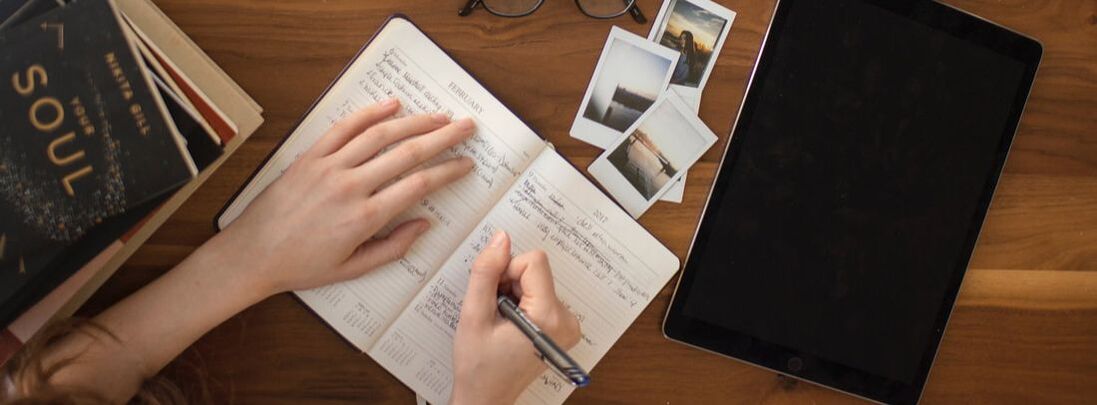Many successful people keep journals. Also, some famous figures in history, like Napoleon or Marcus Aurelius kept journals. This practice has some obvious benefits – it clears up your mind, releases stress, and brings you clarity and inner peace.
There are many varieties of journaling, like keeping a diary; journaling with the Stream of Consciousness technique; keeping a journal from others’ perspective; dream journaling; art journaling; and many, many others. For all of these methods, you can easily find instructions on the Internet. However, in this article, I will focus on a new type of this practice: the Vantage Point Journaling, part of the Reintegration System methodology. Vantage Point Journaling We could say that this is a unique journaling technique. It is different from all other methods in that it initiates writing from four distinctive points of view:
You can adapt your Vantage Point (VP) Journaling practice to your own needs and circumstances. For example, you can keep your diary in a VP Journal form, or practice the Stream of Consciousness technique in a VP Journal framework. Of course, you can apply any other well-known journaling method and do it from several points of view of VP Journaling practice. Vantage Point Journaling is different from all other methods in that it initiates writing from four distinctive points of view.
VP Diary Journaling
This method of journaling is especially good for those of you who need to improve mental clarity, de-clutter the mind, and improve focus. All of us know very well what a diary is. What’s important for this practice is that diary captures streams of thought in an organized and structured way. It requires investing a certain amount of energy and focus on writing. In this framework we will write our diary from several vantage points – the Temporary I,[1] the Heart, another person’s perspective, and Pure Consciousness. The VP Diary Journaling structure is the following: Stage 1: Writing from the Temporary I To begin with your journaling session, do not try to change your mindset or relax too much. Just stay in your current state of mind, whatever it is. Maybe you are anxious, worried, angry, or experiencing any other emotion. You have to write exactly from that state. In this stage, your vantage point is your Temporary I, your transitory I-feeling at that very moment. Just become aware of your Temporary I, its location within your body, and – write. Think about your day, event, or person that you want to write about. The text should be relatively structured, with meaningful sentences. You may be putting on the paper the most important impressions of that particular day, event, or person. Your diary may also relate to thoughts, emotions, new ideas, etc. Let it flow from you. If you are writing in the evening, you can structure your journal by creating a list of questions that you will answer:
Give three to five meaningful answers to each of these questions. When you finish your text, review it. Feel and fully accept main ideas or parts of your text, one by one. You must accept all the main thoughts in the text. By doing that you will effectively remove a great deal of that day’s burden. On the other hand, if you are journaling in the morning, you can create a list of questions related to your goals or action steps for that day, like these:
If you are working with goals, at the end of your text write down the most important goals you are currently working toward. If you want, you can limit the time of writing in this stage, but it should last no less than five minutes. But don’t worry – if you are too tired, it won’t be a problem to reduce your writing to only one or two sentences that comprise your whole day.
Stage 2: Writing from the Heart
The second stage requires you to relax and open your mind. You will probably already find yourself pretty relaxed because the first phase (writing from your Temporary I) has surely de-cluttered your mind to a significant extent.
Now, intentionally move your Temporary I to the Heart.[2] Simply try to feel that the center of your being, your I-feeling, is in your chest, in the Heart’s area. At least for the moment, you will feel yourself as truly centered and balanced. This is the state of “heartfulness.”
Then, write from that vantage point. You will notice a very different perspective. Perhaps you will not be able to write at all, as the state of heartfulness is a deep and relaxing state in which the mind has a minor role. Anyway, you have to be patient and probably some words will pour out from your inner being. Even if it looks to you like a bunch of nonsense, continue your writing. Do not try to over-structure your writing in this phase. Later on, you may be able to find some deeper, hidden meaning of many parts of your text. From time to time, between sentences or parts of your text, try to remind yourself of your Heart, feel again that you are centered in it. Then again, when you finish the writing in this stage, go over main parts or ideas in this phase’s text, feel and accept them, one by one. This and the last two stages may be shorter than the first one. Also, this phase is ideal for writing affirmations, as all decisions and auto-suggestions are much more effective when created and repeated from the Heart. But if you are writing affirmations, do not forget to pay attention to any negative thoughts or emotions that are appearing while you are writing. Those are manifestations of your subconscious obstacles, so accept fully each of them as it surfaces your mind. If you are using the previously prepared questions for your journal, in this phase just be open to some additional ideas or thoughts about each of the questions. Don’t be surprised if some completely new idea or concept related to your goals or life difficulties pops into your mind. If nothing happens, that’s also okay. Stage 3: Writing from Another Person’s Perspective This phase is optional, so you may skip it if during the day you haven’t had any important interactions with other people or you haven’t mentioned any other person in the first two stages. But if you did, it is very important that you write something from the other person’s perspective. Simply imagine that you are the friend, acquaintance, or anyone with whom you had noteworthy encounters during your day. Now that you are her or him, write from their perspective. Jot down whatever comes to your mind. It does not have to be related to the thoughts that you had put on paper in the previous two phases. Whatever comes to your mind, write it down. You might even divide this phase into two sub-phases – writing from the other person’s Temporary I (as you feel it in your imagination), and from her Heart subsequently. You will probably be surprised how big is the difference between these two vantage points of your friend (or opponent). If you had been jotting down answers to previously prepared questions in the preceding two stages, in this phase you don’t have to use those lists at all, just write whatever comes to your mind as that person. Or, if that person is closely related to your goals or wishes, follow your list from their perspective. This stage of journaling will allow you to get a much wider perspective on your life, to understand other people’s behaviors that had not been understandable to you previously. Gradually, your heart will open more and more toward others. You will be increasing your compassion and ability to forgive. Stage 4: Writing from the State of Presence When you get to this final stage of your journaling session, you will easily enter the thoughtless state, i.e. Presence. Your mind will already be pretty much de-cluttered and emptied. But how do you enter the state of Presence whatsoever? Just feel the present moment and yourself at this moment. Feel the totality of you and your surroundings, here and now. There are also many other methods of entering the present moment, some of them are described here. At least for several seconds, you will become thoughtless. Seize that precious moment and immediately continue your writing. The instructions are the same. Just wait that thoughts pour down from your inner being onto the paper. Write for a few minutes. Sometimes you will get some excellent ideas and waves of creativity. Nevertheless, if nothing appears in this stage of, no problem. Do not force yourself. Whatever the case, you may now conclude your journaling session. You can do a shorter version of this practice – to create lists that would have included only a few key words for each item that comes to your mind. Of course, you may expand on some items that require a more detailed description or analysis. Furthermore, you can experiment with creating some artwork instead of writing. It’s up to you, of course. Instead of using a keyboard, I would recommend that you always write with a real pen and paper. That will make your journaling more grounded and efficient. I recommend that you journal at least once a day. The best periods of a day are in the morning, immediately after waking up, and evening, before sleep. After all, you determine your own rules, but then you should stick to them. VP Stream of Consciousness Journaling The Vantage Point Journaling can also be practiced with the so-called Stream of Consciousness technique, which is a style of writing that tries to capture the natural flow of thoughts of the narrator. It typically incorporates incomplete ideas and sensory impressions. Similar to our thought flow, the stream of consciousness is often incoherent, lacking conventional sentence structure and punctuation. This type of journaling is also called “Free Writing.” The Stream of Consciousness technique is a style of writing that tries to capture the natural flow of thoughts of the narrator. 
Image by Free-Photos from Pixabay
The VP Journaling using this technique relies on the same framework as for the diary: first, you write from the current state of consciousness (from the Temporary I), then from the Heart, then from another person’s perspective, and finally from the state of Presence.
How do you write using the Stream of Consciousness technique in each of these stages? Just follow the framework of four phases and write freely from the required points of view. Whatever stage you are at, your text should not have any internal structure. You may write as long as any thoughts are popping up in your head; you will simply feel when the writing is over; or you could assign a certain amount of time for each writing session, so you finish the writing whenever the stopwatch announces the end. When you finish your writing, you don’t have to review the text. Just get and feel a general impression of the text and fully accept it. Example of Stream of Consciousness:[3] Look at that polar bear on the television. Did I take out the trash-wait, I think I threw away a check from mom I need a drink of kool-aid now. The bathroom needs to be cleaned. Where did I put my shoes, I think I should wear shoes while cleaning-I don't like to get anything on my feet (which are in bad need of a pedicure). Maybe red polish next time-or a pinkish orange for the spring-I can't wait for warmer weather. Bottom Line So, what kind of journaling should we choose? It depends on what we want to achieve by this practice. We may want to unload our stress, increase our mental clarity, or improve focus. In that case, we can choose the diary type of journaling. If we want to get valuable insights into our subconscious mind, core values, current situation, and our life in general, we might be more oriented toward the Free Writing style. In both cases, we will increase our creativity dramatically. Our mind will gradually become more and more tranquil, too. Moreover, we will be able to track our overall development and to learn from our achievements and mistakes. At first, journaling may feel uncomfortable or even difficult. If we give it some time we won’t regret it, as the long-term benefits are tremendous. However, we should not abandon our daily meditation sessions. We must not neglect mindfulness, nor the other aspects of our inner work. Journaling, whether the VP variant or some other, cannot fully replace either one of these essential practices, it is rather a wonderful addition to them. Have a great day! :-)
[1] “Temporary I” is our apparent I-feeling at this moment. It is a transitory center within our being that perceives the current experience (external stimuli, emotions, thoughts, and physical sensations). It shapes our reality, even creates many details of it. Temporary I is not fixed at a single location in a human being. Depending on many factors—usually on a state of consciousness—it moves within the body, sometimes even outside of it, although we may rarely be aware of that.
So, you need become aware of the location of your current I-feeling, or Temporary I. How do you do that? Try finding your sense of “I” while reading this very text. Where is the center of your being at this moment? What is the I-feeling you get when you experience contents of the mind, in this case, the text of this book? The location of that I-feeling may change in relation to the specific nature of the mind content within your reality. In many cases, the Temporary I is placed on an imaginary line, connecting the brain and the Heart. Typically, our Temporary I is located in our head, neck or upper chest. [2] The word “Heart” here does not refer to the physical heart itself, nor to the left-of-chest physical location of the heart, but to the “I-point” area, where people usually point at with their forefinger when speaking about themselves in the first-person singular. That area is like an invisible circle, two or three inches wide, touching the skin from the inside. This Heart is extremely important in our lives—in the Reintegration System, it is considered the true center of our being, the seat of the soul, and the source of love and energy. The Heart is the source of our individual reality, and it’s crucial to comprehend and appreciate its importance in our lives. The Heart sends into reality one’s specific vibration frequency, which is the sum of one’s beliefs, emotions, and other patterns. It is also vital to have harmony between the Heart and the Mind. [3] Source: https://www.softschools.com/examples/literary_terms/stream_of_consciousness_examples/345/
0 Comments
Leave a Reply. |
Please note that most of the articles have a "Read More" break, which is sometimes hardly visible.
It is located at the bottom of visible part of the article, on the right side. To continue reading the article, click on that link. This page may contain affiliate links meaning we earn a commission if you use those links.
We only recommend pages we appreciate and trust. Archives
March 2023
Categories
All

|
For guest posts or placing ads on our website, please use the contact form on the 'About/Contact Us' page.



 RSS Feed
RSS Feed

